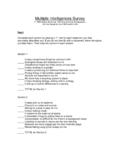Transcription of Lobster Holding Tank System Manual - Fish Aquarium & …
1 Lobster INSTITUTE Lobster Holding Tank System ManualIntroductionTypes of Holding Tank Systems Tank ConstructionRefrigerationPumpsFiltration Water QualityDiseasesIntroductionBuilding and maintaining Lobster Holding systems is a vital part of the Lobster industry. Lobsters from Maine are shipped around the globe, often to places far from the sea, and they need to be stored in tanks . The guidelines set out in this Manual will answer most of the commonly asked questions about how to set up a Lobster Holding System and maintain live and healthy and Appearance of LobstersLobsters should be banded, not plugged.
2 Plugged lobsters are more susceptible to gaffkemia or red tail, a fatal bacterial infection that enters a Lobster through a wound or break in the shell. Therefore, the shell and membrane should be free of any perforations and the antennae should be long with no evidence that they have been chewed. Chewed antenna are a sign that lobsters have been previously stored, since lobsters chew on each other when held in crowded conditions such as pounds or cars. New Shell LobstersA new shell Lobster , sometimes called a "shedder" or soft shell, is one that has recently molted. This process allows the Lobster to grow.
3 New shell lobsters have less meat per unit total weight and have a softer shell. Since their shells are more vulnerable to puncture, new shell lobsters should be handled carefully. There is also more cannabalism among new 1. Examine every Lobster . Remove and market or process lobsters that are weak and those with cracked shells or claws first. 2. Always set crates down gently. Never drop them, even a few inches. The sharp shell projections will pierce the shells and membranes of the lobsters that are inside the Band lobsters that have no of Lobsters to WaterTanks are usually loaded at 1 pound of Lobster to 2 gallons of saltwater.
4 Reservoir storage is included in this calculation. You can calculate tanks and reservoir size as 462 cubic inches (or .267 cubic feet) per pound of Lobster . Here are some standard conversions which may be handy when calculating loading and filter of Holding Tank SystemsThe simplest type of Lobster Holding tank System is an open or flow-through System . In an open System , water is pumped directly from the ocean into the tanks and then drains back into the ocean. This design consists of two basic elements: tanks for storing lobsters and pumps to circulate water. Aeration may also be used to ensure adequate water oxygenation.
5 The open System is most appropriate in coastal locations with good water may also be held in a closed or recirculating System . Recirculating systems differ from open ones in that water in the System is continually recycled. Since water is reused, the design must include not only Holding tanks and circulator pumps, but also aeration, filtration, and refrigeration to maintain proper water conditions. Recirculating systems are best for inland locations or at sites with poor water quality. Tank ConstructionThere are many types of tanks that can be used for Lobster storage. They may be designed to hold lobsters loose or in crates.
6 A plywood box lined with mat or woven fiberglass and coated with resin is commonly used. Crates in a tankEither polyester or epoxy resin may be used. However, caution is needed with polyester resin. New polyester resin will leach styrene into the Holding System . If it is a recirculating System , the styrene can accumulate to toxic levels. Epoxy resin leaches fewer chemicals, but is four times more expensive than polyester. An economical compromise is to fiberglass the tank with polyester resin and, after the polyester cures, coat it with one or two coats of epoxy either case, the tank System should be thoroughly flushed to ensure removal of all toxic leachates from the resin.
7 To flush a tank, fill it with water and allow it to soak for 24 hours before draining it. This process should be repeated on a daily basis for a period of two weeks. The water should not have any resin taste or smell after flushing. Stainless steel and plastics like PVC are also used in Lobster tanks . Used bulk milk tanks from dairy farms, which are equipped with refrigeration, are excellent for Holding lobsters. There are also many manufacturers of glass display is often used in open systems, but it should be lined for closed recirculating systems due to potential leaching of aluminum and other metals that may be in the sand used to make the tank in an open systemTo reduce the cost of refrigeration, it is advisable to have 2 inches of styrofoam insulation around the outside of the tank.
8 An insulated tank cover is also should be constructed of stainless steel, food-grade vinyl tubing, or PVC pipe. PVC pipes should be glued so that a minimum amount of glue collects inside the pipe. Glue must be allowed to dry thoroughly (1-2 days) before putting lobsters in the tank. Plumbing should be flushed with fresh water to remove leachates. For PVC pipe, one day of flushing is usually glue to outside of PVC pipeCopper pipe should not be used, as copper is toxic to lobsters. Dissolved copper from the pipes will accumulate in the water and reach lethal levels within several alloys (brass and bronze), lead, and zinc should also not be used anywhere in the System .
9 RefrigerationThe tank should be kept as cold as possible, as long as it's above freezing. At low temperatures, water holds more oxygen and lobsters are less active and require less oxygen. Cannabalism and the threat of disease are also reduced. About 5% of all lobsters will have gaffkemia, a disease that is fatal to lobsters but harmless to people. The colder the water, the longer the infected lobsters will survive. A reasonable temperature to aim for is 40-45 degrees F. The refrigeration unit (or chiller) consists of a compressor and cooling coils, also referred to as a heat exchanger.
10 In most systems, the cooling coils and compressor are one unit. One System has a submersible chiller that is immersed in the tank to cool the water. Other systems have a chiller separate from the tank and water is pumped from the tank, through the chiller unit, and back to the tank System . The preferred System uses a titanium external chiller. When selecting a compressor, you should get advice from someone knowledgeable about refrigeration who can help determine the correct capacity of the compressor and appropriate refrigeration coils. No copper or copper alloy should be used in any part of the System at any time.





